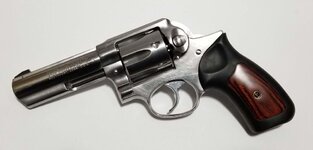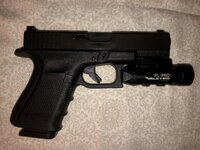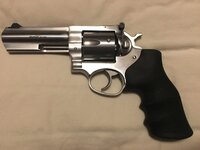- Messages
- 239
- Reactions
- 581
I have gotten some great advice on this forum, so here we go again ...
A few years back I picked up a very nice Ruger GP100, Standard Model 1715 w/ a 3" bbl. It's a great revolver, well-built and reliable. However, sight upgrades are hard to come by without extensive and costly customization.
I could sell her, but I guess I am sentimental. So now I am in the market for a .357 revolver that comes with night sights that can be replaced as needed, 4" bbl preferred. I like .357 because it packs plenty of punch without the insane recoil of the .44 Mag, and you can always shoot .38 for practice/economy. Primary purpose of this weapon would be nightstand duty, with occasional open carry on the trail or in the woods.
So far I have looked at the Ruger Redhawk 5059 and about a half-dozen nice-looking S&W models. Since the Ruger I have is stainless, I would prefer to go with classic wood grips and bluing.
So what do you all recommend? Looking for a 'Top 5' list if possible. Thank you all!
A few years back I picked up a very nice Ruger GP100, Standard Model 1715 w/ a 3" bbl. It's a great revolver, well-built and reliable. However, sight upgrades are hard to come by without extensive and costly customization.
I could sell her, but I guess I am sentimental. So now I am in the market for a .357 revolver that comes with night sights that can be replaced as needed, 4" bbl preferred. I like .357 because it packs plenty of punch without the insane recoil of the .44 Mag, and you can always shoot .38 for practice/economy. Primary purpose of this weapon would be nightstand duty, with occasional open carry on the trail or in the woods.
So far I have looked at the Ruger Redhawk 5059 and about a half-dozen nice-looking S&W models. Since the Ruger I have is stainless, I would prefer to go with classic wood grips and bluing.
So what do you all recommend? Looking for a 'Top 5' list if possible. Thank you all!
















